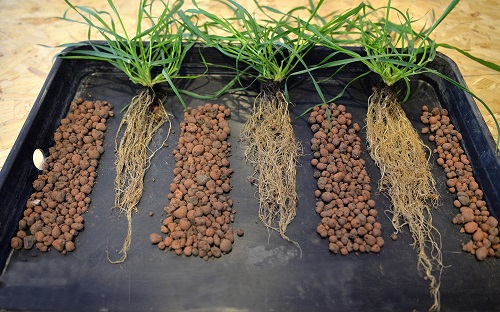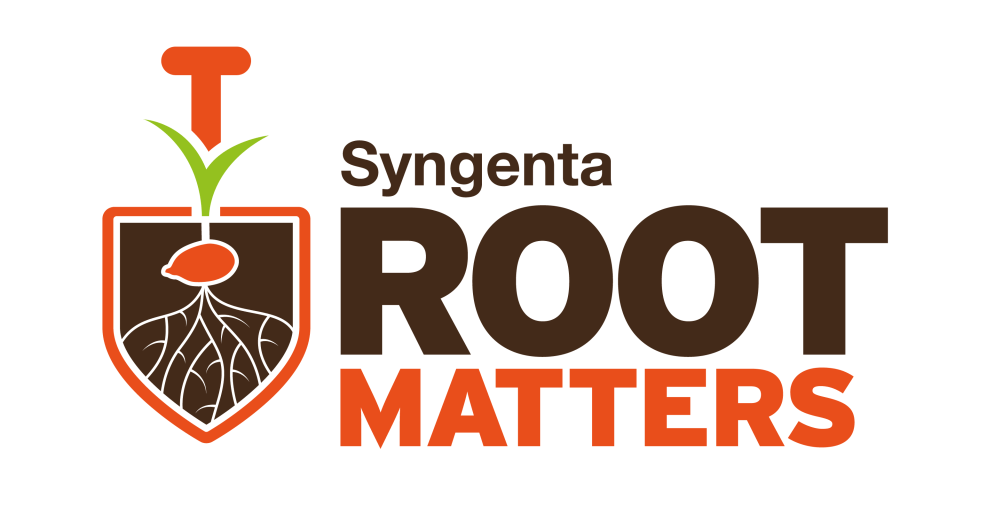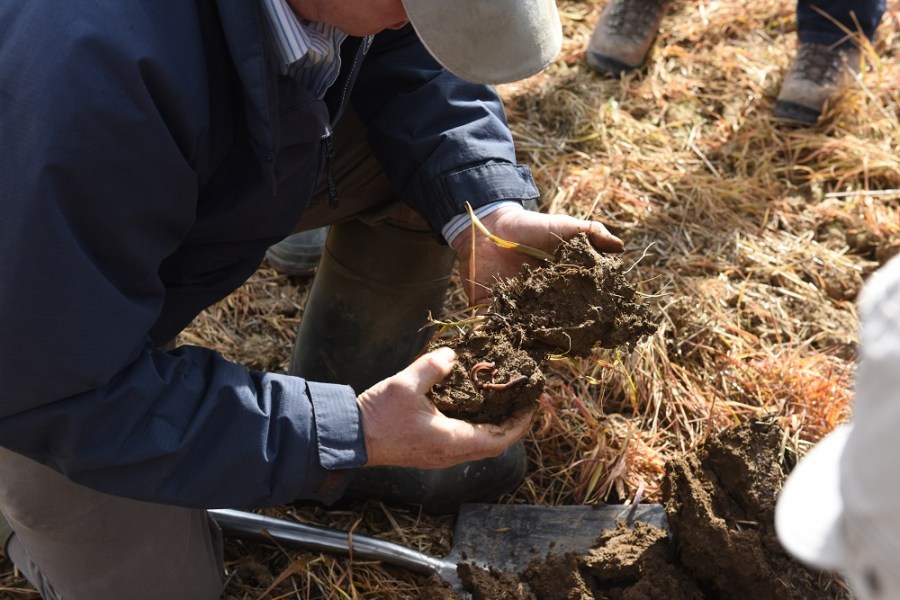A group of growers are embarking on a quest to discover more about root growth and how to influence it. CPM reviews recent research that suggests there’s a lot to learn.
This ability to root at depth appears to have reduced over the past two to three decades.
By Tom Allen-Stevens
As you prepare the ground for the seed you’re about to bury, have you thought about how you’ll manage its growth? That’s growth below the soil surface that you can’t see, rather than the green material that’s routinely managed above it. Research suggests this is an area that’s been neglected and roots are suffering as a result.
“Over the past few decades, growers have been spoilt with a brilliant array of chemical solutions that have helped them deal with the challenges they face, such as weeds, foliar disease and pests. But chemistry just gets you to the next limiting factor,” points out Dave King, head of technical at Syngenta.

Below the plough layer, the root length density of today’s wheat plants falls short of what they need.
“The ultimate restraints on growth are sunlight and water. Growers are very accomplished at maximising sunlight capture through managing the crop canopy above ground. But the problem with encouraging roots is that you can’t easily monitor progress, so any issues are naturally neglected.”
Herbicide and pesticide resistance could now be compounding the problems, he notes. “As growers look to manage blackgrass and BYDV through later drilling and cultural methods, this puts greater emphasis on establishing a good root structure in what could be challenging conditions. But this is the key to delivering more tillers, more ears/m² and ultimately more yield.”
Expert advice
That’s the aim of Root Matters, an initiative from CPM and Syngenta. Working with a core group of growers (see below), its objective is to unearth some of the secrets of how roots develop, and bring to the surface expert advice and relevant research that’ll help improve crop growth.
And a recent, industry-funded study suggests there’s less root mass beneath the soil surface than there was two or three decades ago, says Prof Roger Sylvester-Bradley of ADAS. “For a plant to capture adequate water and nutrients, it needs a root length density (RLD) of at least 1cm length per cm3 of soil, known as the critical RLD,” he explains.
“The comforting news is that wheat modern plants usually have that in the top 30-35cm of soil. But below the plough layer, the average RLD falls short of what a plant needs. The worrying aspect is that this ability to root at depth appears to have reduced over the past two to three decades.”
These were the conclusions drawn from the ADAS study, published in 2015. It looked at trials conducted on 17 commercial crops of winter wheat and 40 of oilseed rape in which rooting at depth was measured. These data were then compared with a smaller, reference dataset (three wheat and one OSR) carried out in the 1970s and 80s.
For OSR, the study suggests plants on average retain a critical RLD down to around 45cm, and a comparison with the previous study suggests this hasn’t changed much below a 20cm depth. Rooting in the top soil horizon (0-20cm) has shifted, however: mean RLDs close to the surface currently average 2.7 cm/cm3 – around a third less than the reference value – although there’s a huge range from 0.6-7.4 cm/cm3.
But it’s wheat that seems to show a dramatic drop in RLD, notes Roger Sylvester-Bradley. The results suggest the average RLD in the top soil horizon has reduced to just a quarter of what it was previously (see chart below). What’s more, while a crop in the 1980s retained a critical RLD down to a healthy 86cm below the soil surface, today’s crops don’t generally support enough roots to feed themselves below 32cm, according to the study.

“This is likely to have a yield impact, especially where crops with a low RLD experience a dry spell,” he adds. A simple model of water uptake and yield was used to gauge this over three soil types with differing available water capacity. The yield penalty in wheat is up to 3.5t/ha in water-limited conditions, compared with the reference crop, while for OSR, up to 1.2t/ha could be lost. “These losses will only get worse as climate change takes hold,” he notes.
So what’s caused the big shift in rooting at depth? “We’ve no conclusive evidence that answers this,” admits Roger Sylvester-Bradley.
“The suspicion is that modern-day cultivation techniques have mitigated against the development of deep roots. We also suspect modern wheat cultivars may have a reduced ability to put down adequate roots, although evidence of this has been insufficient.”
However, a recent study, funded by AHDB and University of Reading, published in May 2017, has put this notion to the test. The research study by Dr Christina Clarke, now of ADAS, set out to determine whether there was a genetic marker, or QTL (quantitative trait loci) for rooting at depth. “Breeders may have been putting all their energy into the genetics that brings biomass and green area index above ground, but blindly breeding out the traits that deliver RLD,” she suggests.
“So we looked at Shamrock, a variety that has a genetic introgression from wild emmer. This landrace of wheat is reputed for its survival in dry conditions. We compared results with Shango, that doesn’t have this introgression.”
Rooting performance
A number of doubled-haploid (DH) progeny of the two varieties were also assessed. Shamrock has a non-glaucous canopy phenotype and the variety has a distinctive viridescence in the field – a trait known to have come from wild emmer. Both DH and parent lines were screened for this QTL and others associated with rooting performance and their RLD was assessed at various depths. Alongside field experiments, seedling roots were measured and plants were grown in rhizotrons – a 1m-deep by 30cm-wide thin slab of soil held with clear acrylic, allowing root growth to be studied.
“Shamrock had greater RLD at depth than Shango, both in the field and within the rhizotrons,” reports Christina Clarke. “There was a correlation between the genetic marker and the rooting characteristics which is significant. However, it’s a weaker correlation in the field than in a controlled environment. We can’t confidently say that the presence of the QTL will result in better rooting performance in the field.”
This suggests that better roots will largely come from how you manage the soil and the crop in the field, says Roger Sylvester-Bradley. “Is helpful to estimate whether the crop is getting a good depth of roots, and we’ve been assessing this for entrants in the Yield Enhancement Network (YEN), using a rather rough-and-ready calculation.”
Growers in YEN measure total crop biomass at harvest, which relates to water usage by their crop, so with a knowledge of the soil’s available water capacity (AWC), and summer rainfall we can estimate likely minimum rooting depth, he explains. “Andrew Hunt near Norwich was a YEN winner who appears to have developed a good way to grow rye, for example. In 2015, his crop achieved a remarkable 20.7t/ha biomass on a coarse sandy loam with 30% pebbles. We calculated the roots of this crop must have grown to a depth exceeding 4m.
“Every farmer should know the AWC of their soils – on average a soil holds 15% of its volume as available water, but this varies from 5-35%. It’s enormously important, since if you know this, and how well your crop has grown, you can make some inferences about rooting at depth.”
Influencing it is a long-term strategy, however. “Most of the crop-available water in the soil profile is held below the depth of cultivations, so better root exploration will happen indirectly through maintenance of cracks and pores. Deep-rooting cover crops can help here – good rooting begets good roots – and anything you can do to encourage earthworms will open up pores that roots will explore. Heavy machinery causes compaction at depth that will restrict root growth, however.”
Deep rooting is crucial for resilient yields, he notes, although crops sometimes don’t need to burrow deep to find everything they need. “Plants are simple things – if they can find water and 13 elements in just the topsoil they’ll thrive. It’s when conditions turn against them that they’ll need to access resources from depth.”
But direct monitoring of root performance on farm, especially rooting at depth is nigh impossible, he believes. “You can use a Dutch auger, which will give you an idea, and digging deep holes at flowering can be revealing. But a truly scientific assessment is costly, laborious and requires specialist equipment.”
Direct monitoring
But Jonathan Ronksley of Syngenta reckons relatively simple dig-and-wash tests can reveal a lot about rooting performance. He’s used these for a number of years to assess the effect on rooting of seed dressing Vibrance Duo (fludioxonil+ sedaxane).
“The first step is to have something to compare against, so do a split-field trial and change just one or two inputs or practices. Then keep everything else the same, so pick a field that’s even, drilled on the same date in the same conditions, with the same cultivations,” he advises.
Early rooting assessments are best made at GS22-23, by collecting around 20 plants from both experiment and control areas. “You have to take care to dig up the whole plant with the root, which is easier on lighter soils. Then wash the roots carefully before making your assessments. Measuring root length and weight, as well as foliar weight will give you some valuable comparative data on performance.”
He believes the wet harvest conditions will present some challenges for root growth this autumn, which could skew how crops perform. “Combines compacted the soil more than normal. Where blackgrass is a problem, cultivations will take place early with soils then left until later drilling, and they can slump unless a catch crop is used.”
But his assessments have shown that Vibrance Duo does improve rooting over a standard Redigo (prothioconazole) dressing, whether it’s used early in the autumn or later on. “For later drilling dates, speed of establishment is the key, which is where it helps. If drilling early, there’s no difference in speed, but Vibrance Duo increases rooting and tillering.”
What’s more, the differences in rooting seen early on tend to persist through the season, he says. This was shown through growing wheat plants through to GS55 in pipes filled with clay balls, which allowed root mass to be measured accurately.
“You can see it in the field, too – some of the plots where Vibrance Duo was tested were hit by drought in May this year. The treated plots were visibly healthier, and we expect there to be yield benefits,” reports Jonathan Ronksley.
Farmer Phil looks below ground for better returns
Phil Jarvis has what he calls the ‘Farmer Phil’ test when it comes to trying something new. “Can I take something someone else has proved and make it work for me?” he asks.
As manager of the GWCT Allerton Project on the Loddington Estate, Leics, on-farm trials are part of the fabric. “I usually ask three basic questions when we’re trialling something – how much will it cost? What’s the return? And what else will it do for me?” he says.
He’s now part of a core group of Root Matters farmers conducting on-farm trials over the next year, looking to find out more about root growth and what he can do to improve it. “There’s a lot we don’t understand about what goes on beneath the soil surface, because we’ve been so concerned with getting it right above ground. Now margins are tighter, yields have plateaued and it’s not enough just to consider the crop canopy.”
And it’s something of a natural progression for Loddington – for many years the estate has been involved with research looking at issues such as soil and water management and is part of Defra’s Sustainable Intensification Research Platform. Most recently, on-farm trials have looked at cover crops as part of Kellogg’s Origins Group of farmers, who have spent the past three years with a total of 500ha of trials, investigating how to get the best from them in a project led by NIAB.
“What we’ve learned is that you can recover about 40-50kgN/ha, and the cost of growing cover crops roughly equals the financial return you get from them. But we’re looking for longer rotational gains than just the impact in the next crop, such as an increase in organic matter and better structure giving our soils more resilience. Also the benefits are less on heavier land and the challenge is to make cover crops work better on these soils,” says Phil Jarvis.
“In the Root Matters trial, we’re planning to look at the interaction of different tillage systems with seed dressings, and what this does to root growth. Monitoring progress through the season may be a challenge, though. It’s easy enough to compare yield, size of plant and growth above ground, and we’ll use a penetrometer to assess any differences in soil structure. But a true picture will only come from digging up plants and comparing roots, which may be more time-consuming.”
A number of other growers have joined Phil Jarvis in the group and are planning to conduct their own on-farm trials. John Haynes of MJ and SC Collins, based in Essex, plans to trial new high-yielding Group 4 wheat Shabras, dressed with Vibrance Duo, against one of his other wheats, dressed with his standard seed treatment. “We’re also dabbling with some direct drilling, so plan to incorporate that into the trial,” he says.
At AW Mortier Farms, near Woodbridge in Suffolk, Richard Parry plans to pitch Vibrance Duo against Redigo on a crop of Shabras. On the Whittingehame Estate in East Lothian, Scotland, Chris Leslie is also bringing Beret Gold (fludioxonil) into his comparison, and intends to find out whether Vibrance Duo makes a difference on late-drilled Grafton. “The variety’s a bit of a shy tillerer, so worth exploring what can be done below ground to encourage it,” he says.
Root Matters
 Root Matters is an initiative from CPM and Syngenta that aims to unearth some of the secrets of how a crop develops beneath the soil surface.
Root Matters is an initiative from CPM and Syngenta that aims to unearth some of the secrets of how a crop develops beneath the soil surface.
Together with a core group of growers, we’ll be looking at how to conduct simple assessments of crop and soil health. We’ll explore the implications of agronomy decisions on root mass and plant stress management, and the interaction of this with variety choice. It combines ‘citizen science’ from the group, with practical field trials at Syngenta’s Innovation Centres, through to high level technical R&D.
The aim of this interactive initiative is to develop practical solutions and information to help farmers get more from their wheat crops. We hope to deliver a better knowledge and understanding of crop rooting systems, and work together to develop practical solutions to help farmers get more from their wheat crops. www.syngenta.co.uk/root-matters




